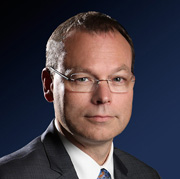Last fall, during a grim period for many of the nation’s hospitals and by any measure a stressful time for VUMC, we did something few institutions would. We held a community survey. Not surprisingly, the responses were not “sweetness and light.” While the survey did confirm that our people see and appreciate the tremendous value of their work, there was also concern expressed about our sense of direction. While anxiety about the future is inevitable during periods of stress and transition, it was made clear we need more communication about the direction we are headed, and how we will get there.

While commentary about the external environment and our organization’s priorities is shared through VUMC Reporter articles and in these periodic “Rounds” pieces, we needed to accept there was room for improvement in how we were “connecting.” Not surprisingly, members of our large organization wanted greater opportunity for face-to-face discussion with leaders and colleagues.
To respond, senior leaders from across the Medical Center conducted Elevate Town Hall meetings, where nearly 1,500 of us engaged in lively exchange aimed at “connecting.” The dialogue centered on real issues impacting all of us, ranging from the staffing reductions of last year, to changes in benefits and FlexPTO, to challenges we experience with our information systems. These sessions were informative for all who attended and candid — we had genuine dialogue about the present and the future.
I am grateful that so many of you attended, and for your questions, comments and suggestions during the sessions and in the post-event surveys. With your guidance, these sessions will continue as a regular way to share information and receive continuing feedback. We will hold the next Elevate Town Hall series soon after the New Year. I can easily imagine that these sessions will become a new part of our communication engine and collaborative culture — a strong tradition at VUMC.
The size of our Medical Center, with well over 20,000 people, can at times be a double-edged sword. Our size allows us to do extraordinary things in all mission areas. In education, we can train clinicians to manage diseases that are uncommon in the population, but yet are critically important to recognize and treat. In research, we can leverage large patient populations to accelerate clinical trials aimed at vital therapies, and we can find answers to pressing questions about the causes of rare but dangerous drug side effects using “big data” methods. In the realm of patient care, only a very large center can garner the resources and skills to care for the region’s and nation’s sickest patients, particularly those with rare and complex conditions.
Our size allows our people to explore a broad and diverse range of career development opportunities while remaining in our organization. Our size is also “buffer” against external forces in health care, much the way large ships at sea are less likely to be capsized during a storm. While we have certainly experienced our own challenges over the past year, the news media regularly reminds us that many smaller hospitals in our region and across the country have closed or are being sold as they are challenged to navigate the changing health care economy.
At the same time, our size and complexity require us to be ever more attentive to ensuring we have deep, intricate and reliable ways to communicate with one another. And with VUMC’s reconfiguration as a financially distinct entity, enabling further growth of our health affiliate network, the opportunities to impact health will be anchored in the quality of our connectivity not only here on campus, but also across our multi-state region.
So in addition to the town hall meetings, we have begun to imagine other ways to improve our connectivity. We have ramped up the dialogue about our most important strategic initiatives with our leaders “on the ground,” the nearly 1,000 clinical leaders and managers working across all divisions of VUMC. Through these individuals, we aim to strengthen and enrich our connectivity to all faculty and staff. We are holding special assemblies where these leaders not only hear information, but also have an opportunity to dialogue easily with one another and with senior leaders. For example, at one session we discussed the sea changes in the manner we are paid for patient care, and why those changes are impacting us so profoundly. These sessions are also providing a new venue for area leaders to share their challenges and ideas about how we can become more efficient and effective at the local level, while also making the working environment more rewarding for their teams.
Strategy is sometimes easier to craft than it is to communicate. We all understand our high level missions — patient care, discovery and education. We all wear the Credo on our ID badges. But how do those high-level priorities actually play out in our own work settings where the rubber meets the road? And as we deal with not only the everyday challenges, but also the new ones forced upon us by the changing economic circumstances of health care?
To help better communicate the Medical Center’s many strategies for success, we are working with our managers and all of our Patient Care Center leaders to create a set of performance goals tailored to each unit’s own unique work setting. The goals closely reflect VUMC’s enterprise-wide strategic priorities, updated each year and also articulated in our clinical enterprise Pillar Goals. Through this effort at goal alignment, we are building a pragmatic connection strategy at the local level using performance targets designed to have greater meaning in each individual operating unit. We don’t want working areas to see their goals as generic, or worse, “top down.” Rather, our targets should be tailored to be meaningful and motivating to the people who know best what it will take to succeed in their own work settings.
“Connecting” requires us to acknowledge our strengths, and also our warts. The good news is that having weathered myriad challenges last year, our “ship” is in a stronger position than ever before, and we are able to focus on the issues that require immediate attention. For example, we are working as quickly as possible to address staffing needs in areas where market demand exceeds supply, bolstering our recruitment processes and shortening the time to fill vacant positions. And we have renewed our focus on implementing new information tools to help make health care documentation work simpler and more valuable for the care of patients. For example, “One Clicks” streamline the process to schedule patients for multiple clinic visits on the same day, and is now being implemented across all VUMC clinics. And we are also implementing SmartVU, a new interface that works on tablet computers and can be used for reviewing patient charts, note taking and prescribing.
The culture of VUMC is anchored in its connectivity. The holiday season reminds us that connecting with family and friends is important for our happiness and well-being. At VUMC, the quality of our connections supports our working relationships with one another, and helps to ensure we are all “rowing the boat in the same direction.” Our Medical Center is fundamentally strong because its people are extraordinary — and when connected and aligned in purpose, we are simply unstoppable.
Sincerely,
Jeff Balser, M.D., Ph.D.
Vice Chancellor for Health Affairs
Dean, School of Medicine














